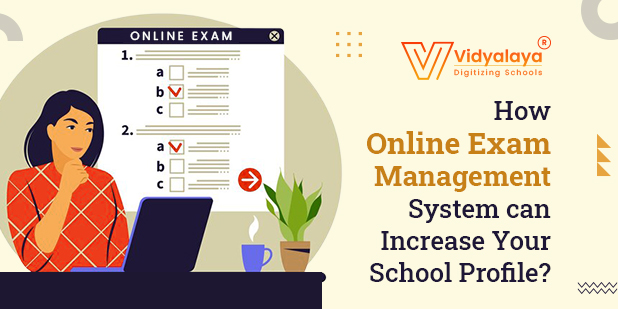The COVID-19 pandemic has created havoc in several sectors principally the all-important education sector. From kids to higher sections student education of all the students has been impacted due to these unprecedented circumstances. But as one of the famous personalities quoted “Turn your obstacles into opportunities and your problems into possibilities”. The educational institutes around the globe have adopted the technology and used it in an efficient way to manage the student’s studies. They have ensured that the whole academic year doesn’t get disturbed so they have used online educational systems to manage all the related to the students.
What is an Online Examination System?
The most important parameter for analyzing the student’s performance that is “examinations” were canceled or postponed due to the lockdown. As a result, the schools have shifted to online examination systems for conducting the student’s assessments. The online examination software is a system through which schools or colleges can conduct exams of multiple students at the same time. The main purpose of online examinations is to test the subject knowledge of the students. In online-based educational systems, the school administration can set up the questions and answers according to their question bank in the system and define the basic criteria of the exams. Thereafter student appears in the exams and answers the questions in the predefined time frame. once the time is completed the test screen collapses. After that instant evaluations of the exam is done. Additionally, once the test is completed the students can review the complete test with real-time results. The schools can conduct the objectives(MCQ based questions) or subjective typed of exams. In objective exams, instant evaluations of questions are done whereas in subjective types the teachers need to check the online exam and evaluate it. Lastly, the management can have various real-time reports of the conducted online test.
Managing Online Exams
1. Define Question Banks:
Question banks are considered as important questions for exams> SO the first step is to add all the questions in the question banks. One can add them to different subjects. For example, if it is a question of the physical map in social studies subject then the admin team can also upload the mages in form of attachments. Additionally one can add various mathematical formulae and special characters in the special editor. In MCQ-based questions also one needs to define the choices and correct the key of the answers based on it only online software will able to evaluate the students answer.
2. Setup the Tests:
Once the questions are added we need to create the whole online exam setup it includes the following.
i. Define start date and time:
The school admin team needs to add a date and time to publish the exam, on that particular date and time only the exam will be visible to the students.
ii. Marks and ranking levels:
With this function, one needs to define the total marks from which the test is conducted and ranking levels if applicable.
iii. Negative marks setup:
If the negative marks apply to the tests the schools can also set up the negative marks applicable to per question.SO according to it the student’s wrong answers will be calculated.
iv. Set the alert duration:
As the ringing bells are there in traditional exams same in e-tests for reminding the final few time frame of the tests schools can set alert duration. So once it’s set the time digital clock which is displayed while appearing the test it blinks in alert duration.
v. Highlight the guidelines:
As students might be new to the system one can mention the basic steps of start-up remakes hence a student can appear in exams with proper steps without any mistakes.
vi. Assigning questions and activating the test:
This last step of the test setup. The questions which are defined in question banks can be assigned here according to their difficulty level. Then we can activate the exam. Activation can also be done to preferred students, like if we don’t want to activate it for the students whose attendance is not good then we can deactivate for those sort of students. Finally, all the needed procedure is completed hence we can lock the exam so no one can do further change in it.
3. Appearing in the E-exams:
The students can be ready in time and virtually attend the exam. With their credentials, they need to log in to the application. In the allotted time of the exam, the only test will be started. Students can firstly check the guidelines of online tests hence they can give exams without any hustle. With a digital clock displayed according to the time frame, students can easily check the time and give their answers. Once the time completes the window will collapse. If the test is MCQ based, the students can instantly check the marks and review every question. If it’s a descriptive based exam and teachers will evaluate and mark them after that they will be getting the result.
4. Online test grading, evaluation, and publishing results:
In the MCQ or objective test, the automated evaluation is done as per the setup done in question banks. As soon as the test completes students get the result furthermore they can review every question. In descriptive or subjective answers once the test is completed the teachers need to check and mark them in the software itself and then they can publish the result. They can publish the results with allotting marks and ranks and also they can publish the whole result-sheet. Hence parents can check and assess their kid’s performance.
5. Analysing with reports:
As it’s necessary for a parent of their child’s performance schools are even more concerned as they need to inspect and analyze the performance of all the students. At an institutional level, they need to always improve their school’s results only will get to know the reality after checking the reports and can set a benchmark for other institutes to follow. They can learn which part was easy for students and which was difficult and plan accordingly for the next session. For an individual part also they can guide every student on their weakness and strengths.
Conclusion:
Online examination systems are an economic way to manage the student’s assessment in the current situation where the economy is in a recession state globally. It benefits the institutes with no issues of misplacing manual papers, no possibility of calculation mistakes, and more importantly, the data is secured and stored on the cloud.





















